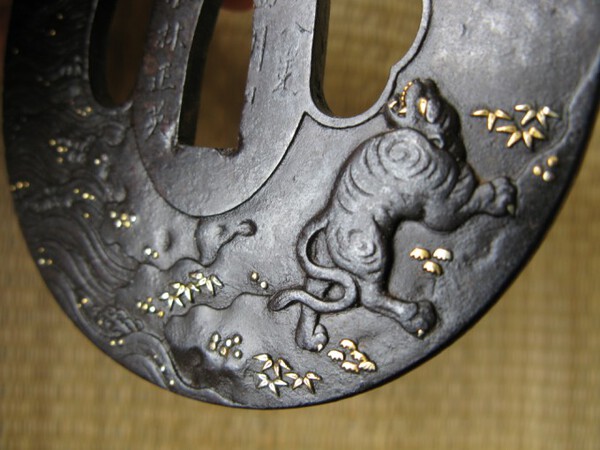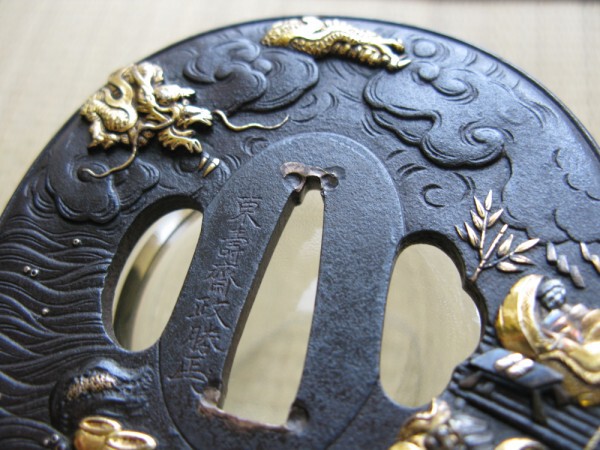-
Posts
43 -
Joined
-
Last visited
Contact Methods
-
Website URL
http://www.bushidoboutique.net
Profile Information
-
Interests
Music
Nihonto, Prints, armour and fittings
Home renovations
Reading
Recent Profile Visitors
The recent visitors block is disabled and is not being shown to other users.
Rich Thomas's Achievements
-

Juyo Yamato Taima
Rich Thomas replied to Vermithrax16's topic in Auctions and Online Sales or Sellers
This is another beautiful Taima blade https://yuhindo.com/taima/ -
Hey Bazza, Sooooo, when Andrew stopped in at Al's on the way back to Melbourne he had this sword with him...he allowed us a quick look, as rightly so he was really proud of this polish, and pretty much blown away by the sword. It's beautiful. This is the best shinshinto I've seen in hand. Congratulations mate stunning. The polish is first class, the lines perfect, he is a real talent. cheers RichT
-
Akemi - san from Ginza Chosua kindly sent me a little more info on Masakatsu, Masakatsu lived in Iwashiro (present western part of Fukushima prefecture). When he was young, he went to Edo and studied under the first generation Ishiguro Masatsune. Masakatsu was given a part of his master's name "Masa" and returned to his homeland Iwashiro. There are 2 kinds of style in his works. One is shakudo nanakoji takabori Ishiguro style and the other is Aizu Shoami style. Some of his works have date: Tenpo 5 nen (1834), Tenpo 11 nen (1840), Ansei 6 nen (1859). And the weather in Tokyo... It has been snowing since this morning. It is very rare to have such heavy snow in Tokyo. I am worry trains might stop. cheers Rich
-
Thanks John, John, Chris appreciated. This seems more elaborate than the normal aizu shoami pieces I've seen before, do you think from the ishiguro influence? Al.... your going skiing? Damn, I'm jealous!! K you can look at it whilst I'm writing on your leg cast! :lol: see ya on the flip side. thanks guys cheers Rich
-
Guido, naturally you are correct! And it is times like this, or every month when I get the magazine, that I wish I could read Japanese (apart from struggling through the basics)! I'm not sure if the writings in Ginza Joho elaborate any more on Masakatsu?... but if anyone does know a little more about him would be great to know, and really appreciated. I have exhausted my small number of research books on tosogu, and have nothing on him specifically. I understand the aizu shoami school in general has mixed reputation due to their excessive production of coarse manufacture or making of imitations, (unsure if this production referred to is just in latter part of Edo period). However they also had a large number of excellent craftsman, producing some outstanding pieces. The school was active from around 1688 right through after meiji restoration. This piece is beautiful in hand, almost purple black colour to the iron plate which I can't catch in the photo's. cheers Rich
-
Couple more from Masahide tsuba Anyway would be interested to know more about these and your thoughts. I love the combination of soft metal and iron, it to me, represents the dichotomy that was the Japanese culture.... the beauty of the geisha and the hardness of the samurai. cheers Rich
-
Hi guys, wondering if anyone had info on Tojusai Masakatsu, particularly the period he was active in. He was from the Aizu Shoami school and also studied under the first Ishiguro Masatsune. I don't have the reference books to do further research on him or the school. Here's a tsuba by him that I fell for (I rarely buy tsuba but seem to be zeroing in on this style : ). This is depicting the story of Susanoo, brother of Amaterasu, and when banished from the plains of heaven (cutting a long story short) he arrived on earth (Izumo province) were he encountered a king that had lost 7 of 8 daughters to an eight headed dragon named Yamato no Orichi, to rectify previous misdeeds he set about saving Princess Kushiinada, and on the bank of a river laid a trap of 8 tubs of saki, the dragon having fallen into a stupor after drinking the saki lost his 8 heads to Susanoo, and within the serpents tail Susanoo discovered the sword called Kusanagi ('grass feller'), ... for those of you wondering .... he married the princess. The reason I say I seem to be zeroing in on this style is this is the one I bought in 2009 at the DTI, which seems to have similar style, I would say maybe same school?. This one is by Masahide and dated 1780 ??? Couple more pics in follow up post cheers Rich
-

Preliminary announcement: New kantei book
Rich Thomas replied to Markus's topic in General Nihonto Related Discussion
Just got my copies. Just want to say ,,,,,, awesome! Thanks Marcus great stuff. cheers Rich -
Hi Paul as suggested by others a very famous Hiroshige print (shono) from the Tokaido gojusan-tsugi series (53 stations of the tokaido). I think this is modern replica as suggested by Malcom the originals had scalloped corners, censor's Kiawme seal in left margin, also the reference examples I have seen all have key block line border. For interest sake the faint writing on the umbrella (on right) is (in the originals) the publishers surname, Takenouchi. There were a number of states and impressions (4 alternates that I've seen) this was often omitted in later impressions. I too love the composition of this print, the traveler's and palanquin bearers running in opposite directions from a sudden squall, the bamboo lending a sense of movement to the print. Note the use of bold triangles of varying depths, and how it captures the violent yet measured rhythms of nature with the hurried activities of man!! Love it, I would have bought it too : ) Rich
-
Hi all, Interestingly at the last Sydney shinsa, a mumei wakizashi was bought in. Gordon R identified it as a joint work by Tanba no kami Yoshimichi and another smith (that I can't for the life of me remember). He was very excited about it because he realised a signed, virtually identical, special order blade was documented in one of their reference books, (partail oshigata and nakago). His explanation was that Yoshimichi and other well ranked smith probably made 3 joint work blades, presented them to the client who selected one, this they signed and it's in the book. The other two sold as mumei. One ended up in Aus. cheers Rich T
-

Essential books and related questions
Rich Thomas replied to Kronos's topic in General Nihonto Related Discussion
Hi James, As a relative newbie I would agree with the direction your being pointed by the guys. Personally I would go with... The craft of the Japanese sword Authors: Leon and Hiroko Kapp, Yoshindo Yoshihara. A must have for the nihonto student, detailing the forging and polishing craft of the sword, plus the making of habaki and shirasaya. An invaluable reference to understand the "how and why" of hamon, hada, & activities. The connoisseurs book of Japanese swords Originally in Japanese called; To-Ken Kantei Dokuhon, by Nagayama Kokan. Translated by Kenji Mishina. Following an in-depth consideration of the history of the sword in Japan, the five traditions of workmanship and some outstanding Edo period examples, Nagayama's guide to sword appreciation expands on criteria to judge sword quality, identify flaws, and ultimately make a correct attribution. English, 560 b&w illustrations. 256 pages, 71/2 x 101/8" hardcover Nihonto Koza Translator: Harry Afu Watson First published in Japan in the mid-thirties, then re-edited and re-issued in the late sixties in the form of a ten volume set. This series has been translated to English and includes all of the pictures and captions from the Japanese version. The translated volumes are 8½ x 11 inches, hardbound, included a glossary, and approximately 500 pages each. Set consists of 3 Koto, a Shinto, a Shinshinto, (not pictured) and a kodogu volume. This is a huge collection of information on the greatest smiths and artisans of their respective times. Definite must have. 100 Masterpieces form the collection of Dr W. A. Compton (can be expensive) Editor: S.Izzard, Published: 1992 This is the well-known reference of important blades and kodogu from the Christie's auctions of Dr. Compton's collection. These one-hundred extraordinary examples are shown in color and b&w plates with super close up of hada and hamon. Descriptions in both English and Japanese. 321 pages, 10¾ x 14¾" hardcover with slipcase Facts and Fundamentals of Japanese Swords Nobuo Nakahara (translated by Paul Martin) for some interesting perspectives As per the others I wouldn't worry too much about Hawleys at this stage ..... some pics etc here http://www.bushidoboutique.net/books.html cheers Rich -

Big exhibition in Paris
Rich Thomas replied to Jean's topic in Sword Shows, Events, Community News and Legislation Issues
Thanks Thierry, great pics; fantastic. cheers Rich T -
Had one shipped a few weeks ago, Fedex, about 3 days to get here, no dramas only hold up was customs for GST (over $1000) = 5 to 10 days. Make sure you get them to write as description 'Antique over 100 years old'. Description of 'nihonto made by xx circa xx AD' might help get them to look after it. You can put the harmonised tarrif code on but not sure if it makes a difference in Aus. Just search harmonised tarrif code here and the post discussing it all should come up. I gotta fly cheers Rich
-
This is my favorite, and one that I would sell my mother, no sister, I mean car for. A signed mid kamakura example. I love this shape. It looks Ko Bizen to me, the shinsa team have place Sanetada in the Fukuoka ichimonji ha, limited references that I have access to place him at different times 1153AD ish or 1278AD ish if I remember correctly. Apparently it is gorgeous in hand. http://www.choshuya.co.jp/sale/sword/0904/sanetada/sanetada.htm cheers Rich Thomas
-
Hi guys, Thought this was a relevant example of one of his midare komi boshi in case anyone interested. Important Cultural Property - Motoshige (Boshi in the pic displaying the ura is more obvious) Click on it and zoom right in http://www.emuseum.jp/detail/100491?word=&d_lang=en&s_lang=ja&class=6&title=&c_e=®ion=&era=&cptype=&owner=&pos=89&num=3&mode=detail cheers Rich











